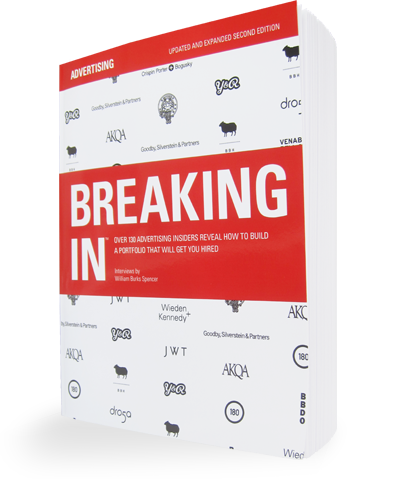Check out some great work from Greg Hahn.
WS: What do you look for in a student book? And what impresses you?
GH: I’ll tell you what doesn’t impress me, which might be easier, is super-finished ads. Because that’s now the price of entry. Before, when you’d see a super-finished ad, it’d be like, “Wow this is really cool.” But then you see so much of that now that it’s like people dress up bad ideas. I’d rather see a really unpolished great idea than something fully blown out that shouldn’t have been. So what do I look for?
WS: Yeah, what do you look for?
GH: I look for a big idea because anyone can do one little joke. Anyone can write a headline, but if there’s a thought that changes the way I feel about something, then, to me, that is bigger. It seems like a lot of ads you see in student books are just one-off little jokey things. And maybe they’re all tied together because they have the same sort of punch-line setup. But if you can do something that really positions the way you think about something completely differently, like, “Wow. I never thought of it that way. But I should have.” That’s what I look for.
WS: You mentioned too much finish. Do you think a book of sketches is enough?
GH: I think that’d be really fresh, yeah. As long as the ideas come across. With some ideas you have to execute a little bit just because they won’t be clear in sketches. But I think it’d be a fresh approach if their idea was good enough, and it just stood on its own without having to shoot it and do all those things.
You see a lot of visual ideas these days. And you just have to execute a lot of those. But I’ve seen so many writers’ books without any words in it. It’s like, “That’s cool, that it’s all about the idea,” but show me you can write too, because you’re going to have to do that.
WS: That was actually my next question: do you think it’s necessary to have long copy in your book?
GH: I do. If you’re a writer, I think you should be able to write. There’s been a lot of times I’ve dealt with people who can do good TV spots, they can come up with good guerrilla ideas, but when they really have to just write like a writer, and put a thought down on paper, they can’t. It depends on what kind of work you want to do too. But I think it’s just a basic skill that you should be able to write because it shows how you think. Writing is thinking. And if you can put that together in a cool way, then it says a lot about the way you think.
[ … ]
WS: How did you get into the business initially?
GH: I snuck in right before these polished ads came out. I had no art-direction training whatsoever. So I just did ideas that were super rough and handwritten, and I went to Kinko’s and sort of Xeroxed it up. And it was during the grunge years. So I Xeroxed it up big so people could read it. And it got all distressed and cool. I’d show it around, and they’d say, “Wow, who did your art direction? It’s really cool!” And I said, “No, it’s just so you could read it.” It looked like I did some effect on it, and made it look like some sort of cool, grungy ’90s art direction. But it was really just because I went to Kinko’s, and cut and pasted my headlines from my dot-matrix printer and just put it down.
But again, now I think every book I see is so polished. Everyone is coming out of Portfolio Center and Creative Circus [ad schools]. I don’t know if I could’ve gotten a job with my little book [nowadays]. I’d almost have to go to school. Then again, if someone came in to me with an idea that was that rough but just had fresh ideas, I think it would stand out.
GH: [ … ]
One thing is, when you start interviewing and showing your book around, you’re not done. To a lot of people, it’s like, “This is the book.” You’ll look back in a year and go, “What was I thinking, putting that in my book?” Because you’ve got to keep continually improving. And looking at a book, it’s hard, as a creative director, but you do it. You’re not supposed to but you’ll grade on the worst ad that you see in there. So if you’re not sure about something, don’t put it in your book. Put in only the stuff you’re sure about. Even if other people have said it’s great, and you have that sneaking suspicion that it’s not, then I wouldn’t put it in. You should be the highest bar. And if someone says that they don’t like something that you’ve done but you really like it, I’d keep that in too because you don’t want to work for someone who doesn’t get you.

Comments are closed.